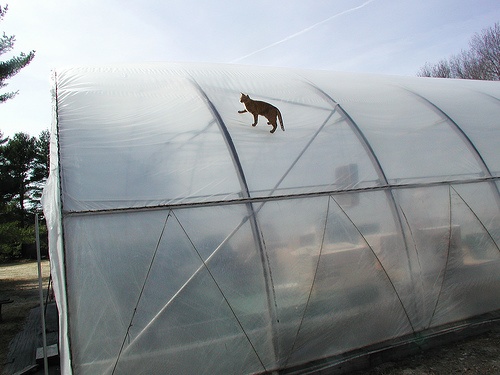Agricultural greenhouses, once a specialty industry devoted to “hothouse” tomatoes and fresh roses in February, are now widely used in many forms and have long been criticized for the high energy costs associated with providing heat and artificial light. These criticisms actually apply only to Controlled Environment Agriculture (CEA), where a fully sealed greenhouse structure uses computer controls to monitor and manage everything in the environment, down to exact light exposure and humidity. In contrast, Modified Environment Agriculture (MEA) greenhouses do not provide either artificial light or heat but still provide protection and insulation from the weather and many other dangers. Nonetheless, with today’s intensifying focus on climate change, alternative energies and environmental sustainability, it’s worth asking this question: Are greenhouses really green?
Benefits
Obviously, greenhouses permit food production in climates that are not well suited to certain crops, or whose growing season is short, such as in the extreme northern or southern latitudes. Local production means lower transportation costs (as well as the associated environmental cost of transport) as well as higher nutrient value and fewer preservatives for the produce itself.
Greenhouses can provide tightly controlled growing conditions that permit optimal crop health, nutrient content, yield and time to maturity. Depending on the type of greenhouse used, extreme weather conditions such as frost, rain or drought, dust storms and even winds can be eliminated, exposure to insects and other pests can be significantly reduced, and conditions conducive to diseases such as blossom end rot can be eliminated.
The controlled environment of a greenhouse permits highly efficient use of water through reduced evaporation, use of drip irrigation systems and in some cases through direct water recycling.
 Costs
Growing under such ideal conditions requires energy, of course, and here lies the real questions: How much do these advantages cost in terms of energy use and what is the environmental price of producing that energy? For many years, the cost of providing light and heat in a typical CEA was prohibitive. In one recent seminar, which considered an innovative vertical farming model, the cost of providing enough light to produce a loaf of bread was calculated at $11. The carbon footprint of the energy required to grow tomatoes for New York City each year was equivalent to the use of over a quarter million US passenger cars.
Fortunately, there are more realistic approaches and improving technology that offer some exciting possibilities for greenhouses, not only in the realm of food production but even in the use of energy production! In our next blog, we’ll consider some sustainable possibilities for agricultural greenhouse power that could substantially raise the cost/benefit ratio of this method of food production.
For information on BTL Liners’ custom fabricated BTL-8 and BTL-12 clear greenhouse covers, please call us at 541-447-0712.
Costs
Growing under such ideal conditions requires energy, of course, and here lies the real questions: How much do these advantages cost in terms of energy use and what is the environmental price of producing that energy? For many years, the cost of providing light and heat in a typical CEA was prohibitive. In one recent seminar, which considered an innovative vertical farming model, the cost of providing enough light to produce a loaf of bread was calculated at $11. The carbon footprint of the energy required to grow tomatoes for New York City each year was equivalent to the use of over a quarter million US passenger cars.
Fortunately, there are more realistic approaches and improving technology that offer some exciting possibilities for greenhouses, not only in the realm of food production but even in the use of energy production! In our next blog, we’ll consider some sustainable possibilities for agricultural greenhouse power that could substantially raise the cost/benefit ratio of this method of food production.
For information on BTL Liners’ custom fabricated BTL-8 and BTL-12 clear greenhouse covers, please call us at 541-447-0712.




